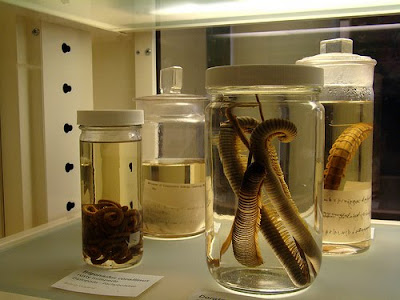Dead things don't float.
Wait, strike that.
Old dead things don't float. And that's a problem if you're trying to create a convincing preserved specimen or "thing in a bottle".
Here are some examples of the real thing from the Harvard Museum of Natural History, nicked from
this excellent collection on Flickr.

Here's another one- a vintage preserved jellyfish from Oxford's Museum of Natural History (taken from
here).

Wonderful, aren't they? Icky, vaguely disturbing, and, like all well preserved biological specimens, they're not bobbing around like corks. Which is where the problem comes in if you're trying to reproduce a prop version. How do you keep your lovingly created bit of nastiness from floating?
Unfortunately, most of the materials that are ideal for long term display in fluid are buoyant. Worse, even materials that are denser than water, like resin and most hardened polymer clays, will float if air is trapped inside. That can really come back to bite you at the worst possible time. Like when you discover your meticulously sculpted masterpiece acts like a life preserver because of the air bubbles in the loosely packed armature of aluminum foil.
The easiest way to get around the problem is to add enough weight to your specimen that it won't float. That can create some problems of it's own, since having your critter banging around on the bottom of it's container looks just as fake as it floating. Not to mention the potential damage that banging will cause of over time.
So how do you find the balance between too heavy and too light? You cheat.
I'll use this worm as an example. I know that, in general, silicone and latex are very close to being neutrally buoyant. That can change based on how much air gets trapped in them as they set up, but a good rule of thumb is that they're just slightly buoyant. That means the body of the worm will want to float. The resin teeth, on the other hand, are heavier than water. That means the creature as a whole is top heavy and wants to flip end for end.

So how do I tweak it to keep it's buoyancy under control? I add ballast, just like in a ship. While you could use anything heavy I think glass (specifically the little decorative glass beads used for flower arranging) is the best material available. It's cheap, readily available, and totally inert. A glass rod inserted into the body of the worm during sculpting will provide more than enough weight to keep it from floating.
Then, to counteract it's now considerable negative buoyancy, I add an air bubble to the upper body. Just like a dive marker or a crabber's marker buoy, the small amount of air trapped in the upper body keeps it pointing towards the surface and acts as a damper on the creatures inertia. Conveniently, a 9/16 plastic bead has just enough air inside to balance a glass bead of equal or slightly larger size.

Admittedly, making sure fake bottled specimens don't float isn't an issue for most people. If it looks creepy, so what if it bobs around? On the other hand, being aware of how to use buoyancy to your advantage opens up some really interesting techniques. If you're crafting a tentacled monstrousity it's pretty handy to know that putting a drop of hot glue inside the tip of latex tentacles will produce a cool floating effect.
Or you could just have someone else do all the work and admire the nifty bottled specimen on your shelf. Coincidentally, the plump worm with the toothy maw, along with some of it's relatives, will
be on Ebay for Black Friday. And nothing quite captures the spirit of the holidays like a bloated, flesh devouring invertebrate.

















































